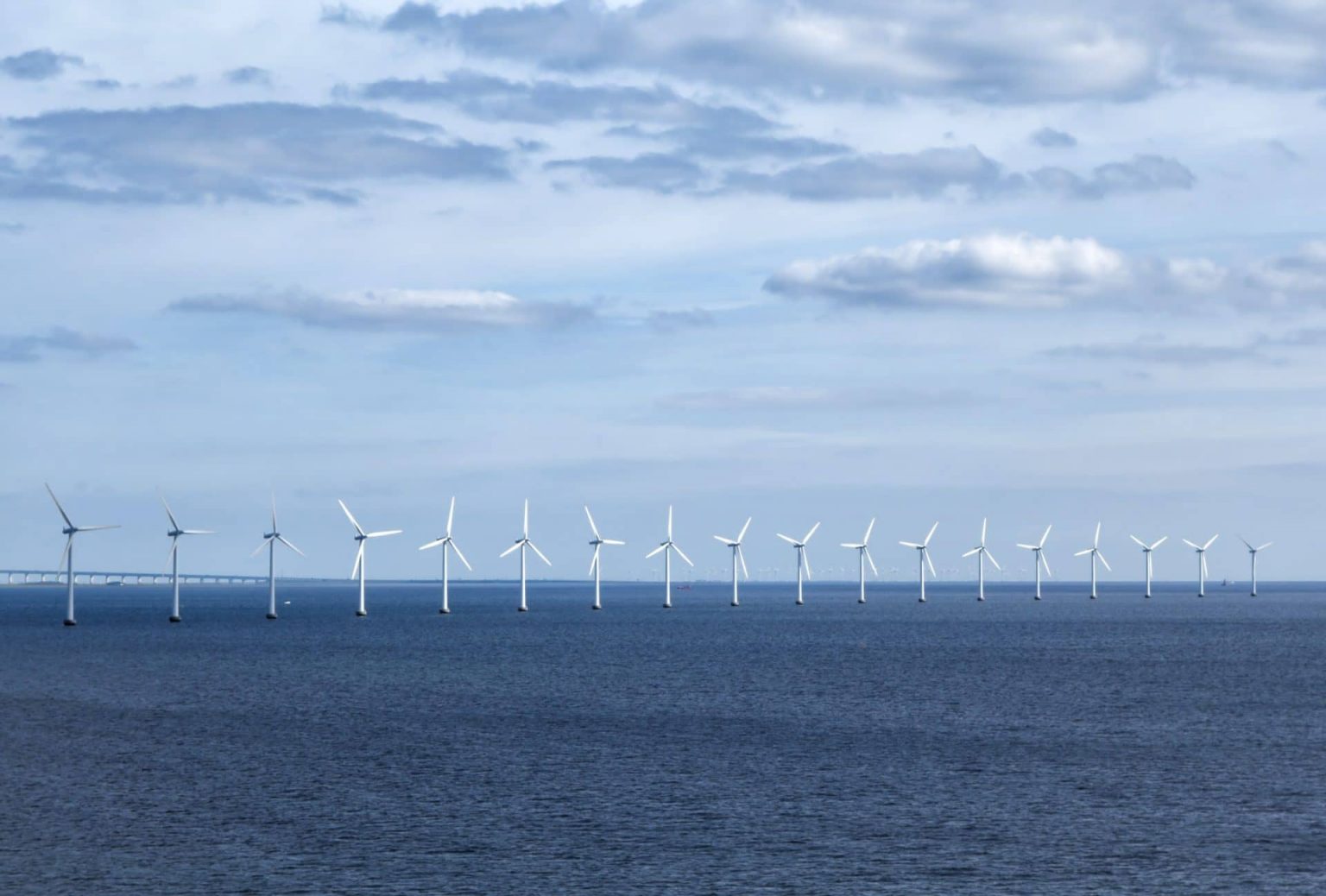
From bigger turbines to batteries – The trends shaping offshore wind’s evolution into a major energy sector.
Better resource captured by super-sized turbines in bigger wind farms reduce the cost of offshore wind.
The biggest impact on offshore wind levelised cost of energy (LCoE) is the use of bigger turbines within larger scale offshore wind farm developments. The UK is at the forefront of this trend. When it starts operation in 2020, Ørsted’s 1.2GW Hornsea One project, 120 km off the East Yorkshire coast, will be the biggest offshore wind farm in operation, comprising 174 turbines each with a 7MW capacity.
Projects like Hornsea One, of gigawatt-scale magnitudes, using the biggest turbines available, are also in development off the European mainland coast and in parts of Asia. Huge wind farms ensure optimal capture of a stronger and steadier wind resource found farther from shore. Reduced LCoE is achieved through having fewer turbines to install, thus fewer foundation structures, fewer interconnecting cables and having fewer turbines to service, maintain and eventually repower or decommission. Projects of such magnitude enable the supply chain to push down costs through economies of scale.
8MW & beyond.
The V164 9.5MW from the MHI-Vestas joint venture is the largest turbine in serial production today, installed at Ørsted’s Burbo Bank Extension, whilst Senvion and Siemens have been linked to 10MW designs for commercialization in the next decade. GE claims its 12MW Haliade-X turbine in development combines a bigger rotor, longer blades and higher capacity factor to save around $26 million (£19.5 million) per turbine per 100MW, over a wind farm’s lifetime, compared with its 6MW machine. If 12MW seems big, Ørsted expects turbines with capacities up to 15MW to be available from mid-2020s, for zero-subsidy offshore wind.
Going AC to DC.
The trend for bigger wind farms further out at sea creates challenges for balance of plant components. (HVDC) transmission is more reliable than HV alternating current (HVAC), sustaining fewer losses and carrying nearly three times as much power over long distances. The growth in renewables, energy storage, demand response and digitalization – technologies enabling the smart grid – benefit from HVDC systems, which offer better performance within networks where generation is more variable and demand less predictable.
Use of HVDC cables to connect Vattenfall’s Norfolk Vanguard and Norfolk Boreas offshore wind farm projects to the National Grid, will avoid the need for cable relay stations near Happisburgh and will also require a much narrower cable corridor offshore and onshore, which will allow Vattenfall to avoid impacting sites of historical heritage and environmental areas.
Transmission and the Grid.
Cheaper batteries
Latest research by Bloomberg New Energy Finance (BNEF) forecasts wind and solar to account for 50% of global electricity generation by 2050, on the back of continued cost reductions, plus much cheaper batteries that will enable intermittent energy generation to be stored and discharged to meet supply-demand shifts.
As offshore wind becomes cheaper then it lowers the cost of decarbonizing the wider energy system, creating a pull for technologies, like energy storage, which enable better integration, eating into shares of coal, gas and nuclear.
In the Batwind project, a 1.3.MWh battery connected to the Hywind floating offshore wind farm, off the Scottish coast, is enabling operator Statoil to increase the value of produced electricity. Dynamic data fed into the system, which includes weather, market and demand forecasts, will programme an algorithm in the storage system and as more data is entered the battery will keep gaining ‘experience’ to extract more value from trading wind electricity.
A 2MW/2MWh battery being installed at Ørsted’s 90MW Burbo Bank, marks the first time an offshore wind farm is integrated with a battery system to deliver frequency response to help balance the grid.
IT advances spanning digital ledger blockchain technologies to virtual power plant platforms could also mitigate the impact of the growing electric vehicle (EVs) load on the grid, by directing charging to occur at times of surplus generation, in turn helping to integrate more renewable energy from wind and solar into the grid. EVs enabled with bidirectional chargers and smart onboard computing could also participate in grid balancing in future
O&M Trends.
Big data enhances O&M strategies
Big wind farms, far out at sea present challenges in terms of servicing equipment cost-effectively and safely. In offshore wind O&M ‘big data’ advances could have a big impact. Systems, like GE’s Predix platform, are being adapted exclusively for offshore environments to support remote diagnostics and allow operators and their O&M contractors to plan in maintenance activity, at times of low production, during calmer conditions at sea. Technician visits to turbines are reduced as the need for reactive maintenance is kept to a minimum.
Vessels fit for the rigors of offshore wind environments
A large portion of O&M costs are spent on the logistics of transporting technicians out to sites. As offshore wind farms are built further out the challenges, risks to safety and costs associated with maintaining these assets increases. Accommodation jackups and transfer vessels have been developed to deliver larger crews from onshore to work on offshore bases, whilst providing higher levels of comfort, will boost technicians’ productivity. Vessels designed to hold more capacity, so more stock and tools can be transported, will also reduce numbers of trips, saving on time and associated costs such as refuelling.
The next wave in offshore wind development.
Floating substructures
Offshore wind faces pressure to reduce costs, whilst addressing extreme engineering challenges imposed by progress in cheaper offshore energy production, which involves huge turbines, in vast arrays, further from shore. Some of the heaviest and biggest components to transport are the substructures need to support turbines in place. Floating offshore concepts originally emerged as the solution for supporting turbines in very deep waters beyond the continental shelf edge.
Towing turbines and anchoring infrastructure seems simple. But, with Statoil’s Hywind the only operational floating offshore wind farm as reference, a huge learning curve lies ahead. Nevertheless, it could mark the small beginning of a fundamental step change in how wind farms are engineered in future.
Export opportunities.
Supply chain collaboration
To achieve consistent scale and growth in the long term the offshore wind sector needs to emphasize supply chain collaboration and think in global terms.
This can mean a mindset where operators work closely with contractors to identify and understand where project risks can best be managed, and, crucially, the supply chain partner best placed to manage them. This approach and openness to using local expertise, skills and labour, exemplified by Innogy, ensures new ideas and approaches get a chance to flourish, benefiting both the wider offshore wind sector and local job markets.
Global standardization
According to projections from the International Renewable Energy Agency (IRENA), growth in offshore wind energy will accelerate in the coming years, with installed capacity rising from 19.2GW in 2017 to 521GW in 2050. Efforts to ensure offshore wind is competitive with other forms of power generation will both guarantee the sector’s relevance in Europe’s energy future and ensure British and European firms have a role to play in the global offshore wind industry, not just in project engineering, but in turbines, components, substructures, balance of plant equipment, O&M and vessels.
According to IRENA, offshore wind pioneers, including the UK, Germany, Denmark and China, have adapted offshore wind standards, customizing legislation, certifications and regulations, to consider local market conditions. The industry will also benefit from having these conditions reflected in international standards, avoiding the need to meet different requirements for each market, enabling economies of scale and reducing transaction costs, all of which will ensure offshore wind can be competitive for the widest number of markets with exploitable resources.
For more information, contact:
Share this insight


